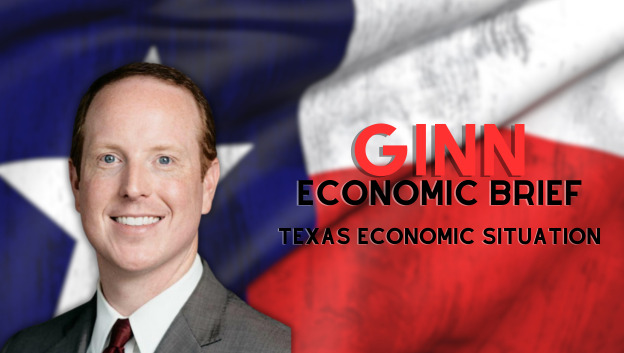
Texas has been a leader in job creation. But Texas faces major headwinds as this year’s 88th Legislature has looked more like California than what Texans expect. There is a better way.
- This included the largest spending increase, largest corporate welfare increase, and subsequent second-largest property tax cut in the state’s history.
- Texas should pass universal education savings accounts the ongoing third special session called by Gov. Greg Abbott (R).
- Texans expect more from the largest red state in the country.
Free-market capitalism is the best path to let people prosper, as it is the best economic institution that supports jobs and entrepreneurship for more people to earn a living, gain skills, and build social capital.
Table 1 shows Texas’ labor market for September 2023 from the U.S. Bureau of Labor Statistics.
| December 2007 | February 2020 | April 2020 | September 2023 | |
|---|---|---|---|---|
| Labor force participation rate | 65.7% | 63.8% | 60.3% | 64.2% |
| Employment-population ratio | 62.8% | 61.6% | 52.6% | 61.6% |
| Unemployment rate (U3) | 4.4% | 3.6% | 12.8% | 4.1% |
| Total nonfarm employment | 10.57M | 12.97M | 11.51M | 14.05M |
| Private sector employment | 8.78M | 10.96M | 9.56M | 11.98M |
3) April 2020—Dated trough of the last U.S. recession, and 4) September 2023—Latest data available.
The labor market continues to improve in Texas even as there are some weaknesses.
- The payroll survey shows net nonfarm jobs in Texas increased by 61,400 last month, resulting in increases for 40 of the last 41 months, to bring record-high employment to 14.05 million. Texas has set a record high in total nonfarm employment for 24 straight months.
- Compared with a year ago, total employment was up by 435,800 (+3.2%)—the second fastest growth rate in the country—with the private sector adding 372,900 jobs (+3.3%) to 11.98 million and the government adding 62,900 jobs (+3.1%) to 2.07 million.
- Figure 1 shows that inflation-adjusted average weekly earnings are increasing in most industries in Texas, with inflation still running hot at least at 3.7%.
Figure 1. Texas’ Labor Market by Industry

- The household survey shows that the labor force participation rate is higher and the employment-population rate matches those in February 2020, but the former is well below December 2007 at the start of the Great Recession.
- The state’s unemployment rate of 4.1% is higher than the U.S. rate of 3.8% but this is a weak indicator as it’s highly volatile based on changes in the labor force, and the labor force continues to increase in Texas.
- Shortages in the labor market are across the economy as many still sit on the sidelines from profligate safety nets primarily from the federal government over the last three years.
The economy continues to expand in Texas though there are headwinds.
- The U.S. Bureau of Economic Analysis (BEA) reported the real gross domestic product (GDP) by state for 2022.
- Figure 2 shows Texas had the fifteenth fastest real GDP growth of +3.0% to $1.94 trillion in 2023:Q1 (above the U.S. average of +2.0% to $20.28 trillion).
Figure 2. Texas had the 15th Highest Real GDP Growth in 2023:Q1

- The BEA also reported that personal income in Texas grew by 6.7% to $1.94 trillion in 2023:Q1 which was the 22nd highest in the country. This is above the U.S. growth rate of 5.1% (to $22.51 trillion).
As Texans face an affordability crisis from high inflation and high property taxes and an uncertain future with the U.S. economy likely in a deepening recession, the Legislature provided some tax relief but not nearly enough because of excessive spending.
- Other states are cutting, flattening, and phasing out taxes, passing responsible budgets, and passing school choice, so Texas should have made bold reforms to support more opportunities to let people prosper, mitigate the affordability crisis, and withstand destructive policies out of D.C.
- Figure 3 provides a comparison of the size of government, economic freedom, and economic outcomes among the four largest states and nearby Louisiana.
Figure 3. Comparison of Key States
| Measure | U.S. | Florida | Texas | Tennessee | Georgia | Louisiana | California | New York |
|---|---|---|---|---|---|---|---|---|
| Economic Freedom of North America (2020) | 7th (World) | 1st | 4th | 4th | 8th | 20th | 49th | 50th |
| State Migration Trends, Most Inbound (2022) | — | 1st | 4th | 11th | 12th | 48th | 41st | 50th |
| State Business Tax Climate (2023) | — | 4th | 13th | 14th | 32nd | 39th | 48th | 49th |
| State Economic Outlook (2023) | — | 9th | 13th | 11th | 12th | 26th | 45th | 50th |
| State & Local Spending Per Capita (2022) | — | 46th | 37th | 45th | 48th | 26th | 4th | 2nd |
| S&L Spending on Public Welfare Per Capita (2020) | — | 47th | 44th | 31st | 49th | 12th | 5th | 1st |
| S&L Tax Burden Per Capita (2022) | — | 11th | 6th | 3rd | 8th | 12th | 46th | 50th |
| S&L Property Tax Collections Per Capita (2020) | — | 22nd | 39th | 4th | 19th | 7th | 36th | 46th |
| Composite Cost of Living Index (Q1:2023) | — | 31st | 17th | 10th | 12th | 14th | 49th | 48th |
| Avg. U-3 Unemployment Rate (2003-22) | 6.0% | 5.6% | 5.6% | 6.0% | 6.3% | 5.9% | 7.3% | 6.2% |
| Avg. Labor Force Participation Rate (2003-22) | 64.0% | 60.6% | 65.2% | 61.8% | 64.4% | 60.1% | 63.5% | 61.5% |
| Avg. Annual Nonfarm Payroll Growth (2003-22) | 0.8% | 1.4% | 1.8% | 1.0% | 1.1% | 0.1% | 1.0% | 0.6% |
| Avg. Top 5% Income Shares (2003-18) | 36.9% | 44.6% | 36.8% | 33.6% | 34.2% | 32.2% | 39.4% | 47.1% |
| Official Poverty Measure (2019-21) | 11.2% | 12.5% | 12.9% | 12.2% | 13.1% | 17.2% | 11.0% | 12.3% |
| Supplemental Poverty Measure (2019-21 | 9.6% | 11.9% | 10.4% | 9.1% | 10.2% | 11.7% | 13.2% | 12.1% |
- While Texas does relatively well, there is much more to do for more liberty and prosperity.
The Texas Legislature should improve the Texas Model by:
- Passing pro-growth policies that:
- Spend Less: Lower state government spending and pass responsible local spending limits.
- Tax Less: Start eliminating local property taxes with historic surpluses at the state level to buy down school district M&O property taxes and at the local level by using their own surpluses to buy down their own property tax rates.
- Regulate Less: Improve workforce development, remove barriers to work, reduce occupational licensing, reform safety nets, and enact universal school choice.
Strengthening the Texas Model will help Texans better resist D.C.’s overreach and flourish more for generations to come.
Texans for Fiscal Responsibility relies on the support of private donors across the Lone Star State in order to promote fiscal responsibility and pro-taxpayer government in Texas. Please consider supporting our efforts! Thank you!
Get The Fiscal Note, our free weekly roll-up on all the current events that could impact your wallet. Subscribe today!




